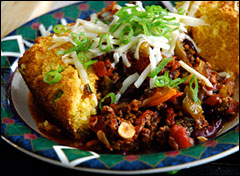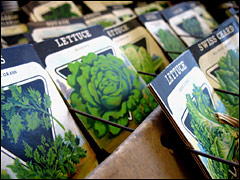Editor’s note: Welcome to the first installment of Chef’s Diary, a new biweekly recipe column by Iowa-based chef Kurt Michael Friese. Follow the seasons with a professional chef — and get tips for cooking at home.
As the last of last fall’s bounty comes out of the larder at my Iowa City restaurant, my wife Kim has been poring over seed catalogs, trying to shake the chill of a particularly nasty prairie winter. Eagerness to plant supplants many other priorities as she rifles through each newly arrived issue like a 12-year-old boy with a lingerie catalog. Plans for this year’s garden become an obsession that quickly grows out of all reasonable proportions, resulting in a seed and seedling order that could be of better use feeding a small African country.
The thing she will eventually remember is that she need not order everything now, and if she waits to order some of the crops that should be planted later in the year (that is, May or June), the enthusiasm that germinated in the short, icy days of February will have subsided, and the realism needed for a successful spring planting will yield a healthy harvest.
When you begin planning your garden, be reasonable about how much space you actually have and how much work you are really willing to put into tilling, preparing, and weeding. Remember that planting and harvesting are the two easiest parts of gardening, and it’s all the stuff that comes in between that can be backbreaking if you overdo it. There are only a few things you really need to order now: the heartier greens and early spring vegetables that are the harbingers of the summer bounty.
Examples of greens that can handle the spring chill are mache and kale. Radishes are wonderful and are among the first things you will be able to plant, as soon as you can dig the soil. Sweet peas love the early spring cold, as well. Take a look at the planting instructions for each, consider how much you really do have room for, and don’t order too much.
When perusing the seed catalogs, try to stick to open-pollinated seed. Unlike hybrids, the seeds they produce come up true to variety, so you can hold some back for next year. True heirlooms are of this type, carefully nurtured over generations, sometimes millennia, to be suitable for a certain climate, certain soil, even certain dietary preferences of the people growing them.
Of course, if you would like to start your own peppers and tomatoes from seed and you haven’t already, you’ll want to get them going right away — indoors, under a grow light and with proper warmth and water. If you’re not equipped for that, you can select seedlings from the Seed Savers Exchange Catalog and they’ll send them to you later in the spring when it’s actually time to put them in the ground. Seed Savers is the best choice for the true “heirloom” varieties that lend delicious diversity to your garden. If you are fortunate enough to live where the farmers’ markets are already up and running, look for seedlings there. It’s always good to shake the hand that raised the food.
Meanwhile, take a look at your compost. Give it a good turn and make sure your compost bin handled the winter intact. Check the soil, and start pulling back last fall’s layer of mulch. If yours is a new garden, get a soil sample kit from your county extension office, where for just a few bucks they can tell you what’s good and bad about the soil in that spot so that you can decide what will grow best there or what kind of nutrients it needs (always organic, please!).
When your spring fever begins to break in April, you can start thinking about the giant pumpkins, award-winning squash, and more delicate greens you want to plant. And can we ever have enough herbs in our gardens? Oops, there I go.
Iowa City Chili
There’s still a chill in the air here in the Heartland, the kind of windy, rainy days that drill into your bones and create a hankerin’ for a rib-sticking bowl of chili. It’s also a great way to empty out the larder of the last of your tomatoes, peppers, and other “puttin’ ups” (as my grandma used to call them).

Ward off the chill with hearty chili.
1 1/2 pounds lean ground beef (preferably grass-fed), bison, or chopped tempeh
1 tablespoon olive oil
2 medium onions, diced
4 cloves garlic, minced
3/4 teaspoon salt
1 teaspoon fresh-cracked black pepper
1 medium green bell pepper, diced
1 medium red bell pepper, diced
1 cup corn kernels (frozen is fine)
4 tablespoons (or to taste) hot smoked Spanish paprika
2 hot peppers of your choice, seeded and minced
1/2 pound (dry weight) cooked pinto beans
1 pint canned diced tomatoes (use San Marzano brand for best flavor if you didn’t can your own)
1 pint tomato puree
12 ounces dark beer (such as bock)
4 tablespoons toasted cumin seed, ground
1 tablespoon Worcestershire sauce
In a large stockpot, cook ground beef, bison, or tempeh in olive oil over medium-high heat with onion, garlic, salt, and pepper until browned well. Break up meat/tempeh with a spoon as you cook. Add bell peppers, corn, and hot peppers. Continue to cook on low heat until peppers are tender, about 5 minutes. Stir occasionally.
Add the remaining ingredients and gently bring to a simmer. Allow to simmer for 2-3 hours, then turn off heat and allow to cool. Reheat when ready to eat. Serve with grated cheese, chopped onions, corn bread, tortilla chips, or whatever accompaniments you wish.




